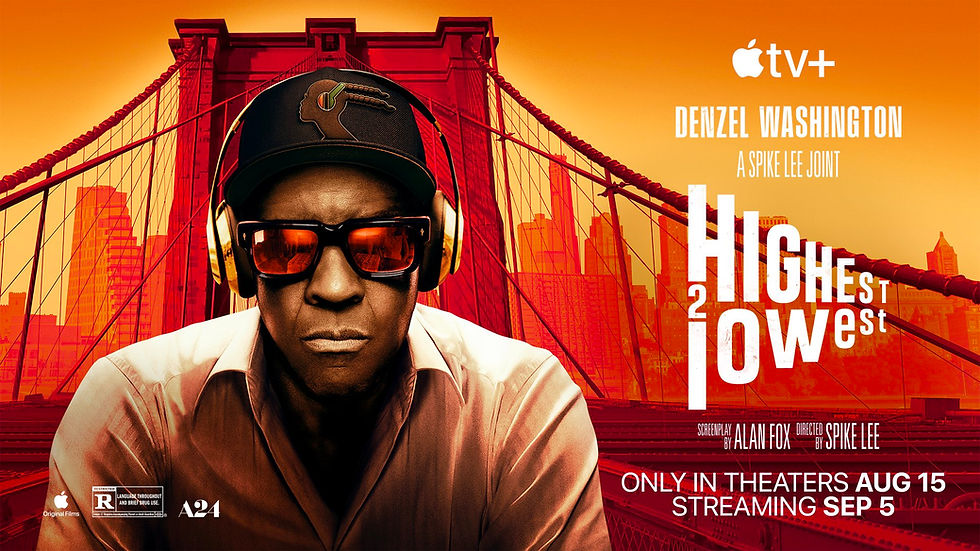Top Gun: Maverick Review
- Louis Saddler
- May 27, 2022
- 4 min read

Calling the wait for a sequel to 1986’s Top Gun long is like calling a Mississippi summer hot because it’s that and then some. Consider this - the kids who watched Top Gun in a theater during its initial release are now old enough to have children who manage said theaters. That level of perspective is needed to grasp how long we were on hold.
Finally, after delays due to everything from a “late” start in development to its original director’s passing to reshoots to COVID, the saga of the 80s favorite naval aviator continues with Top Gun: Maverick. Top Gun: Maverick picks up in the present-day, where Tom Cruise’s iconic character receives a last chance assignment to train a team at his old stomping ground for their most dangerous mission to date.
As the follow-up to a cultural phenomenon, this movie has a lot to prove. On top of that, filmmaking and movie-goers have changed drastically with technology raising the bar for what’s special about special effects and audiences wanting more than machismo from their action films. Does Top Gun: Maverick have what it takes to be a worthy sequel to its predecessor while meeting the mark for today’s action films?
Personally, Top Gun: Maverick’s Ws started for me when I saw more Black people in the trailer than in the entire first film. In addition to that hallmark, I’m happy to say there are other pieces of Top Gun: Maverick that went right to make it one of the most satisfying sequels in recent memory.
The most obvious point of discussion among those pieces is Cruise. He may be playing a character near the end of his run, but Cruise shows he’s far from that as an actor in delivering arguably the most well-rounded performance of his career. He still has the swagger and charisma calling card that made him a superstar as Maverick in the first film, which is apparent via slick retorts or an opportunity to flex his comedic timing.
However, the most impactful aspects of Cruise’s performance come when he shows the growth of Maverick via emotionally weighed scenes in which the character is still struggling with the passing of his friend Goose as well as his and his student’s mortality. It’s nothing we haven’t seen from Cruise before throughout his career, but it’s the first time we see his full range in a single film.
The real key to Top Gun: Maverick working so well is everything behind the camera, starting with the script. The story stays true to the OG Top Gun’s roots and has the space to allow the Top Gun world to evolve to something that makes it more relevant today. It’s still primarily a film about the best pilots in the world preparing for a dangerous mission, and there are plenty of references and homages to the 1986 film. At the same time, it includes heavy doses of humor and heart that humanize the pilots of Top Gun well beyond the one-dimensional characters in the original film.
As cool as it is to have a more layered story, a Top Gun movie would not be a Top Gun movie without the pilots showing what they can do. Director Joseph Kosinski and cinematographer Claudio Miranda combine to give what might be the most immersive in-theater experience since 2019’s 1917.
Kosinski and Maranda don’t use a lot of special effects but instead rely on camera placement inside and outside the jets. That approach gives the numerous aerial combat scenes in Top Gun: Maverick (although most of them are in a training or testing setting) a realistic, natural feel that makes the audience believe they are in the cockpit. Every aerial maneuver hits to a point where you feel the sensation of moving in the sky and the danger if something goes wrong.
The praise for Kosinski doesn’t stop there. Possibly drawing from his experience helming the legacy sequel to 1983’s Tron, 2010’s Tron Legacy, he handles Top Gun: Maverick in a way that should set the standard for all legacy sequels. Kosinski’s decision to insert critical elements from the original film, such as music or specific sequences, where another director would have made updates create a nostalgia that hits from the moment the film opens. He also paces the story well and keeps the plot moving even when no one is in the air.
Ultimately, Top Gun: Maverick is the perfect blend of old and new. It has so much of the original film’s DNA woven into it that long-time fans will feel like it’s 1986 all over again, but it also does an excellent job making changes that give this generation a new blockbuster to call their own. The updates to Maverick’s life and story are welcomed and needed progressions to fit today’s audiences. Nonetheless, Top Gun: Maverick makes its money in the air, and the aerial sequences are easily the best these eyes have ever seen.
Watching the first Top Gun isn’t required, but I would encourage you to do so before seeing Top Gun: Maverick, regardless if it’ll be your first or millionth time because it makes the experience so much better. Because of the outstanding cinematography and filming with IMAX cameras, Top Gun: Maverick is best seen in IMAX or another large-screen format.



Comments